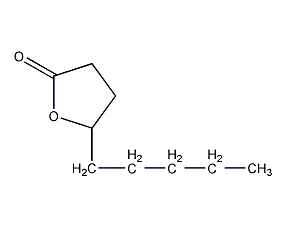
Structural formula
| Business number | 02QB |
|---|---|
| Molecular formula | C9H16O2 |
| Molecular weight | 156.22 |
| label |
coconut aldehyde, Octadecyaldehyde, γ-Nonalactone, 1,4-Nonyl lactone, 4-Amyl-4-hydroxybutyric acid lactone, Ester cyclic compounds and their derivatives |
Numbering system
CAS number:104-61-0
MDL number:MFCD00005403
EINECS number:203-219-1
RTECS number:LU3675000
BRN number:115281
PubChem number:24901323
Physical property data
1. Properties: Colorless liquid with coconut aroma. After dilution, it has a fruity aroma like peach, apricot, and pear.
2. Density (g/mL, 25℃): 0.976
3. Relative vapor density (g/mL, air=1): 4.7
4. Melting point (ºC): 3.6
5. Boiling point (ºC, normal pressure): 243
6. Boiling point (ºC, 1.73kPa): 136
7. Refractive index (n20D): 1.4462
8. Flash point (ºC): 132
9. Specific rotation (º): Undetermined
10. Autoignition point or ignition temperature (ºC): Undetermined
11. Vapor pressure ( mmHg, ºC): Undetermined
12. Saturated vapor pressure (kPa, ºC): Undetermined
13. Heat of combustion (KJ/mol): Undetermined
14. Critical temperature (ºC): Undetermined
15. Critical pressure (KPa): Undetermined
16. Oil-water (octanol/water) partition coefficient relationship Value: Undetermined
17. Explosion upper limit (%, V/V): Undetermined
18. Explosion lower limit (%, V/V): Undetermined
19. Solubility: Soluble in ethanol and most organic solvents, insoluble in water.
Toxicological data
1. Skin/eye irritation: Standard Dresser test: rabbit skin contact, 500mg/24HREACTION SEVERITY, mild reaction; Standard Dresser test: rabbit skin contact, 100mg/24HREACTION SEVERITY, strong reaction; 2. Acute toxicity: major Rat oral LD50: 6600mg/kg; Rabbit skin contact LD50: >5mg/kg; Guinea pig oral LD50: 3440mg/kg; 3. Mutagenicity: DNA repair test: Bacillus subtilis, 20mg/disc;
Ecological data
None yet
Molecular structure data
1. Molar refractive index: 43.40
2. Molar volume (cm3/mol): 163.3
3. Isotonic specific volume (90.2K ): 384.3
4. Surface tension (dyne/cm): 30.6
5. Dielectric constant:
6. Dipole moment (10-24cm3):
7. Polarizability: 17.20
Compute chemical data
1. Reference value for hydrophobic parameter calculation (XlogP): None
2. Number of hydrogen bond donors: 0
3. Number of hydrogen bond acceptors: 2
4. Number of rotatable chemical bonds: 4
5. Number of tautomers: 2
6. Topological molecule polar surface area 26.3
7. Number of heavy atoms: 11
8. Surface charge: 0
9. Complexity: 132
10. Number of isotope atoms: 0
11. Determine the number of atomic stereocenters: 0
12. Uncertain number of atomic stereocenters: 1
13. Determine the number of chemical bond stereocenters: 0
14. Number of uncertain chemical bond stereocenters: 0
15. Number of covalent bond units: 1
Properties and stability
1. This product is non-toxic, has low volatility, and its flash point and ignition point are lower than the boiling point.
2. Exist in flue-cured tobacco leaves and oriental tobacco leaves.
3. Naturally found in beer, wheat bread, pineapples, peaches and apricots.
Storage method
Packed in iron drums, placed in a dry and ventilated place, and stored and transported according to general chemical regulations.
Synthesis method
1. γnonanolide naturally exists in tomatoes, rum, peaches, and barley, but is industrially produced from malonic acid and heptanal.
Add 70g triethylamine and 52g (0.5mo1) malonic acid into a 500mL flask, stir slowly to dissolve, and add 57g (0.5mo1) of newly distilled malonate dropwise within 30 minutes at 40 to 50°C. Heptanal. Then continue to stir the reaction for 1 hour at 75-85°C until no more CO2 gas is released. After cooling, add 180 mL of 20% hydrochloric acid, let stand and separate the layers, and extract the water layer twice with 50 mL of benzene. Combine the benzene extract and the organic layer, wash with water until neutral, and then dry over anhydrous sodium sulfate. First, recover benzene by distillation under normal pressure, then distill under reduced pressure to collect the 130-135°C (666.5Pa) fraction, which is nonenoic acid. The refractive index is nD201.446-1.447. The yield is about 75%.
Place 32.2g nonenoic acid (0.2mol) and 4g HY molecular sieve in a 250mL flask, stir and react at 170°C for 3 hours, filter out the molecular sieve after cooling, distill under reduced pressure, collect 123~128°C (800Pa ) fraction is γ-nonalactone. You can also use 80% sulfuric acid as the lactonization agent, wash with water after the reaction, neutralize with sodium carbonate solution, wash with water, and finally distill under reduced pressure to obtain the finished product.

2.Nonenoic acid is produced by the reaction of heptanal and malonic acid, and then lactonized, followed by extraction, washing and distillation.

3. Tobacco : FC, OR, 18; produced by the addition and condensation of n-hexanol and acrylic acid or methyl acrylate in the presence of di-tert-butyl peroxide.
Purpose
1. Used to prepare food flavors, feed flavors, etc.
2. Used as the main flavor of coconut flavor, and also used to prepare cream , almond, peach, cherry, nut, tropical fruit and other flavors. The usage amount in baked goods is 55mg/kg; in candies, it is 33mg/kg; 28mg/kg in puddings; 15mg/kg in chewing gum. span>; 14mg/kg in cold drinks; 11mg/kg in soft drinks .
3. Commonly used in sweet sauces, baked goods, and puddings.


